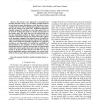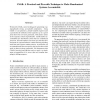172 search results - page 20 / 35 » Learning to Predict Code-Switching Points |
ICDM
2010
IEEE
13 years 5 months ago
2010
IEEE
We present a new approach to semi-supervised anomaly detection. Given a set of training examples believed to come from the same distribution or class, the task is to learn a model ...
ICASSP
2011
IEEE
12 years 10 months ago
2011
IEEE
The Support Vector Machine (SVM) methodology is an effective, supervised, machine learning method that gives stateof-the-art performance for brain state classification from funct...
ECML
2007
Springer
13 years 11 months ago
2007
Springer
Most traffic management and optimization tasks, such as accident detection or optimal vehicle routing, require an ability to adequately model, reason about and predict irregular an...
BSN
2006
IEEE
14 years 1 months ago
2006
IEEE
Ubiquitous computing has established a vision of computation where computers are so deeply integrated into our lives that they become both invisible and everywhere. In order to ha...
NDSS
2009
IEEE
14 years 1 months ago
2009
IEEE
We describe CSAR, a novel technique for generating cryptographically strong, accountable randomness. Using CSAR, we can generate a pseudo-random sequence and a proof that the elem...


